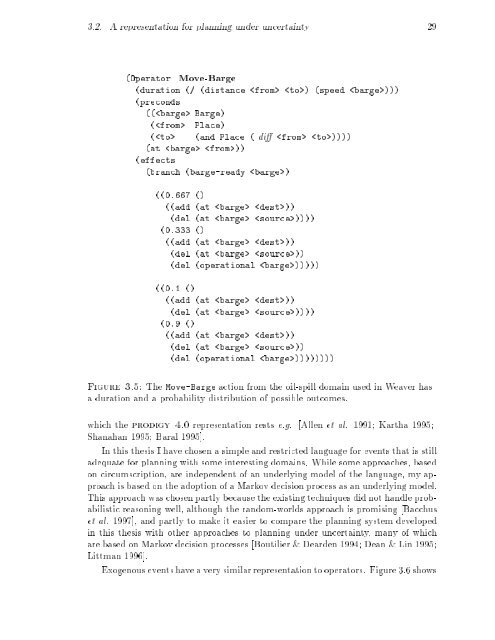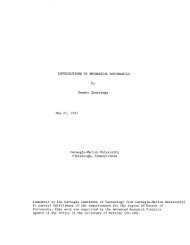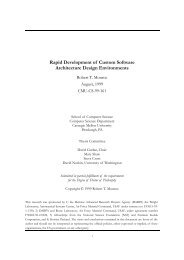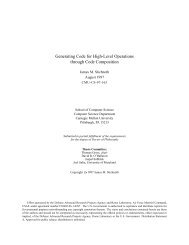- Page 1 and 2: Planning under Uncertainty in Dynam
- Page 3: AbstractPlanning, the process of nd
- Page 6 and 7: 4.3.1 Analysing the belief net and
- Page 8 and 9: viii
- Page 10 and 11: 7.4 Weaver's solution to the exampl
- Page 12 and 13: 3.12 Reachability graph of literal
- Page 14 and 15: 6.1 Operators in the parameterised
- Page 16 and 17: xvi
- Page 18 and 19: xviii
- Page 20 and 21: 2 Chapter 1. Introductionif the pri
- Page 22 and 23: 4 Chapter 1. Introductionweather co
- Page 24 and 25: 6 Chapter 1. Introductionnet nodes
- Page 26 and 27: 8 Chapter 1. Introduction
- Page 28 and 29: 10 Chapter 2. Related workIn additi
- Page 30 and 31: 12 Chapter 2. Related workmakes use
- Page 32 and 33: 14 Chapter 2. Related workall the s
- Page 34 and 35: 16 Chapter 2. Related workValue-Ite
- Page 36 and 37: 18 Chapter 2. Related workdescent [
- Page 38 and 39: 20 Chapter 3. Planning under Uncert
- Page 40 and 41: 22 Chapter 3. Planning under Uncert
- Page 42 and 43: 24 Chapter 3. Planning under Uncert
- Page 44 and 45: 26 Chapter 3. Planning under Uncert
- Page 48 and 49: 30 Chapter 3. Planning under Uncert
- Page 50 and 51: 32 Chapter 3. Planning under Uncert
- Page 52 and 53: 34 Chapter 3. Planning under Uncert
- Page 54 and 55: 36 Chapter 3. Planning under Uncert
- Page 56 and 57: 38 Chapter 3. Planning under Uncert
- Page 58 and 59: 40 Chapter 3. Planning under Uncert
- Page 60 and 61: 42 Chapter 3. Planning under Uncert
- Page 62 and 63: 44 Chapter 4. The Weaver Algorithmi
- Page 64 and 65: 46 Chapter 4. The Weaver Algorithmn
- Page 66 and 67: 48 Chapter 4. The Weaver AlgorithmB
- Page 68 and 69: 50 Chapter 4. The Weaver Algorithm
- Page 70 and 71: 52 Chapter 4. The Weaver Algorithm0
- Page 72 and 73: 54 Chapter 4. The Weaver AlgorithmI
- Page 74 and 75: 56 Chapter 4. The Weaver Algorithmd
- Page 76 and 77: 58 Chapter 4. The Weaver Algorithm(
- Page 78 and 79: 60 Chapter 4. The Weaver AlgorithmT
- Page 80 and 81: 62 Chapter 4. The Weaver Algorithmn
- Page 82 and 83: 64 Chapter 4. The Weaver Algorithm4
- Page 84 and 85: 66 Chapter 4. The Weaver Algorithml
- Page 86 and 87: 68 Chapter 4. The Weaver Algorithmc
- Page 88 and 89: 70 Chapter 5. Eciency improvements
- Page 90 and 91: 72 Chapter 5. Eciency improvements
- Page 92 and 93: 74 Chapter 5. Eciency improvements
- Page 94 and 95: 76 Chapter 5. Eciency improvements
- Page 96 and 97:
78 Chapter 5. Eciency improvements
- Page 98 and 99:
80 Chapter 6. Eciency improvements
- Page 100 and 101:
82 Chapter 6. Eciency improvements
- Page 102 and 103:
84 Chapter 6. Eciency improvements
- Page 104 and 105:
86 Chapter 6. Eciency improvements
- Page 106 and 107:
88 Chapter 6. Eciency improvements
- Page 108 and 109:
90 Chapter 6. Eciency improvements
- Page 110 and 111:
92 Chapter 6. Eciency improvements
- Page 112 and 113:
94 Chapter 7. Experimental results
- Page 114 and 115:
96 Chapter 7. Experimental results
- Page 116 and 117:
98 Chapter 7. Experimental results
- Page 118 and 119:
100 Chapter 7. Experimental results
- Page 120 and 121:
102 Chapter 7. Experimental results
- Page 122 and 123:
104 Chapter 7. Experimental results
- Page 124 and 125:
106 Chapter 7. Experimental results
- Page 126 and 127:
108 Chapter 7. Experimental results
- Page 128 and 129:
110 Chapter 7. Experimental results
- Page 130 and 131:
112 Chapter 7. Experimental results
- Page 132 and 133:
114 Chapter 7. Experimental results
- Page 134 and 135:
116 Chapter 7. Experimental results
- Page 136 and 137:
118 Chapter 8. Conclusions The appl
- Page 138 and 139:
120 Chapter 8. Conclusions
- Page 140 and 141:
122 Appendix A. Proofs of theoremso
- Page 142 and 143:
124 Appendix A. Proofs of theoremsN
- Page 144 and 145:
126 Appendix B. The Oil-spill domai
- Page 146 and 147:
128 Appendix B. The Oil-spill domai
- Page 148 and 149:
130 Appendix B. The Oil-spill domai
- Page 150 and 151:
132 Appendix B. The Oil-spill domai
- Page 152 and 153:
134 Appendix B. The Oil-spill domai
- Page 154 and 155:
136 Appendix B. The Oil-spill domai
- Page 156 and 157:
138 Appendix B. The Oil-spill domai
- Page 158 and 159:
140 Appendix B. The Oil-spill domai
- Page 160 and 161:
142 Appendix B. The Oil-spill domai
- Page 162 and 163:
144 Appendix B. The Oil-spill domai
- Page 164 and 165:
146 Appendix B. The Oil-spill domai
- Page 166 and 167:
148 Appendix B. The Oil-spill domai
- Page 168 and 169:
150 Appendix B. The Oil-spill domai
- Page 170 and 171:
152 Appendix B. The Oil-spill domai
- Page 172 and 173:
154 Appendix B. The Oil-spill domai
- Page 174 and 175:
156 Appendix B. The Oil-spill domai
- Page 176 and 177:
158 BIBLIOGRAPHY[Blythe & Veloso 19
- Page 178 and 179:
160 BIBLIOGRAPHY[Drummond & Bresina
- Page 180 and 181:
162 BIBLIOGRAPHY[Koenig & Simmons 1
- Page 182 and 183:
164 BIBLIOGRAPHY[Schoppers 1989b] S
- Page 184:
166 BIBLIOGRAPHY







